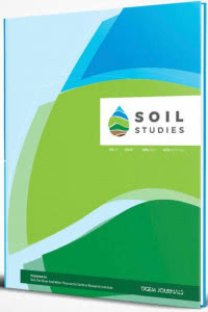Pamuk Bitkisinde Yüzey ve Yüzeyaltı Damla Sulamanın Toprak Sıcaklığı ve Toplam Kuru Madde (Biomass) Miktarına Etkisi
Effect of Surface and Subsurface Drip Irrigation on Soil Temperature and Total Biomass For Cotton Production
___
- Adams WR, Zeleke KT (2016). Diurnal effects of on efficiency of drip irrigation. Irrigation Sceince 35: 141-157, Doi: 10.1007/s00271-016-0529-1.
- Ali IA, Kafkafi U, Yamaguchi I, Sugimoto Y, Inanaga S (1996). Transpiration drop after sudden decrease in root temperature. International Evapotranspiration and Irrigation Scheduling Conference. San Antonio, Texas, USA, November 3-6, 1996.
- Allen RG, Pereira LS, Raes D, Smith M (1998). Crop evapotranspiration: Guidelines for computing crop water requirements”. United Nations Food and Agriculture Organization, Irrigation and Drainage Paper 56, Rome.
- Anonim (2016). Bitkisel üretim istatistikleri. Türkiye İstatistik Kurumu, www.tuik.gov.tr , Erişim tarihi: 15.06.2016.
- Bronson KF, Chua TT, Booker JD, Keeling JW, Lascano RJ (2003). In-season nitrogen status sensing in irrigated cotton: II. Leaf nitrogen and biomass. Soil Sci. Soc. Am. J. 67:1439–1448.
- Colaizzi PD, Evett SR, Howell TA (2004). Comparison of SDI, LEPA and spray irrigation performance for cotton in the North Texas High Plains”. CD-ROM. Irrigation Association Annual Meeting, 14-16 Nov. Tampa, FL. USA.
- Çetin Ö (1993). GAP’ta sulama sistemleri ve su Tasarrufu. ToprakSu Dergisi, 1: 23-24.
- Çetin Ö, Bilgel L (2002). Effects of Different Irrigation Methods on Shedding and Yield of Cotton. Agric. Wate. Manage, Volume 54 (1), 1-15.
- Çetin Ö, Üzen N (2016). Pamuk sulaması. Çiftçi ve Köy Dünyası. TZOB Dergisi, Ağustos, 2016, 38-41.
- Çetin Ö, Üzen N, Temiz MG, Sessiz A (2013). Güneş enerjisi kullanarak damla sulama ile sulanan pamukta fertigasyonda azotlu gübre yönetimi. Dicle Üni. Bilimsel Araştırmalar Koordinatörlüğü (Proje No: ZF-10-166) Desteklenen Araştırma Sonuç Raporu, Diyarbakır.
- Dehghanisanij H, Kosari H (2011). Evapotranspiration partitioning in surface and subsurafce drip irrigation systems, Evapotranspiration-from measurments to agricultural and environmental applications, G. Gerosa (ed.) ISBN:978-953- 307-512-9.
- Dong X, Xu W, Zhang Y, Leskovar DI (2016). Effects of irrigati,on timing on root zone soil temperature root grpwth and grain yield and chemical composition in corn. Agronomy, 6:34, 1-10, doi:10.3390.
- Ertek A, Kanber R (2001). Damla yöntemiyle sulanan pamukta farklı sulama programlarının bitki gelişmesine etkileri. Turk J Agric For 25 (2001) 415-425.
- Gardner FP, Pears RB, Mitchel RL (1985). Physiology of crop plants. Iowa State University Press. Iova, USA, 327.
- Glinski J, Lipiec J (1990). Soil condition and plant roots. CRC Press Boca Baton Fla.
- Harem E (2010). Türkiye’de tescil edilen pamuk çeşitleri. TAGEM, GAP Toprak-Su Kaynakları ve Tarımsal Araştırma Enstitüsü Müdürlüğü, Yayın No: 165, Şanlıurfa.
- Kalfountzos D, Alexiou I, Kotsopoulos S, Vyrlas P (2007). Effect of subsurface drip irrigation on cotton plantations. Water Resour Manage 21:1341–1351, DOI 10.1007/s11269-006-9085-4.
- Karademir Ç, Karademir E, Doran İ, Altıkat A (2005). Diyarbakır ekolojik koşullarında farklı azot ve fosfor uygulamalarının pamukta verim ve lif teknolojik özelliklerine etkisi. GOÜ Ziraat Fak. Dergisi, 2005, 22(1), 55-61.
- Keller J, Bliesner RD (1990). Sprinkle and trickle irrigation. Chapman and Hall, 115 Fifth Avenue, New York, NY 10003.
- Li X, Simunek J, Shia H, Yana J, Penga Z, Gong X (2017). Spatial distribution of soil water, soil temperature, and plant roots in a drip-irrigated intercropping field with plastic mulch Europ. J. Agronomy 83: 47–56.
- Lv G, Hu W, Kang Y, Liu B, Li L, JQ S (2013). Root water uptake model considering soil temperature. Journal of Hydrologic Engineering 18(4): 394-400.
- Özer MS (1992). Harran Ovası koşullarında pamuğun fosforlu gübre isteği. Köy Hizmetleri Şanlıurfa Araştırma Enstitüsü Müdürlüğü Yayınları Genel Yayın No: 71, Rapor Seri No: R-47, Şanlıurfa.
- Özer SM, Dağdeviren İ (1986). Harran Ovası koşullarında pamuğun azotlu gübre isteği. Köy Hizmetleri Araştırma Enstitüsü Yayınları, Yayın No:25, Rapor Serisi No:17, Şanlıurfa.
- Patterson LL, Buxton DR, Briggs RE (1978). Fruiting in cotton as affected by controlled boll set. Agron. J. 70:118-122.
- Phene CJ, Ruskin R (1995). Potential of subsurface drip irrigation for management of nitrate in wastewater. In: Lamm FR (ed) Microirrigation for a changing world: conserving resources/preserving the environment. Proceedings of the 5th international microirrigation congress, April 2–6. Orlando, Florida, pp 155–167, American Society of Agricultural Engineers.
- Swern D (1982). Bailey’s industrial oil and fat products. A Wiley Interscience Publication, Vol. 2, 1-69. USA.
- ISSN: 2146-7072
- Yayın Aralığı: 2
- Yayıncı: Toprak Gübre ve Su Kaynakları Merkez Araştırma Enstitüsü
SPEI ve SPI İndisleri Kullanılarak İstanbul-Damlıca Deresi Havzasında Kuraklık Şiddetlerinin Analizi
Ulusal Dinamik Rüzgâr Erozyonu Modeli Ve İzleme Sistemi Bitki Örtüsü Parametresinin Belirlenmesi
Reşat AKGÖZ, Kenan İNCE, Günay ERPUL
Birsen KARABÜK, Kudret KEVSEROĞLU, Zeynep DEMİR
